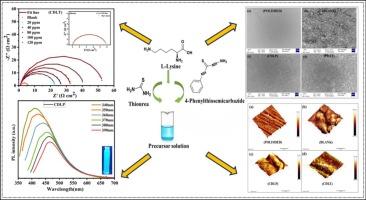新型碳点在酸性环境中作为低碳钢高效绿色缓蚀剂的合成:电化学、重量和XPS分析
IF 7.3
2区 材料科学
Q1 CHEMISTRY, APPLIED
引用次数: 0
摘要
采用一步水热法合成了碳点CDLP和CDLT。当这些碳点溶解在15% HCl溶液中时,作为水溶性、廉价、环保的缓蚀剂,可以抑制低碳钢(MS)的腐蚀过程。合成的CDLP和CDLT通过FTIR、UV-Vis、PL、XPS和HRTEM进行了表征。采用动电位极化分析、电化学阻抗谱分析和失重测量分析对CDLP和CDLT的缓蚀效果进行了测定。在120 ppm浓度和303 K温度下,CDLP和CDLT的抑制率分别为96.50%和90.21%。CDLP和CDLT在质谱表面的吸附遵循混合吸附(物理吸附和化学吸附),符合Langmuir吸附等温线。极化电位研究表明,CDLP和CDLT作为混合型抑制剂,同时降低了MS在阳极和阴极上的溶解速率和析氢反应速率。利用FESEM、EDX、AFM和XPS分析了被抑制样品的表面形貌,证实了在质谱表面存在一层保护性抑制剂层。本文章由计算机程序翻译,如有差异,请以英文原文为准。

Synthesis of novel carbon dots as efficient green corrosion inhibitor for mild steel in an acidic environment: Electrochemical, gravimetric, and XPS analysis
Carbon dots CDLP and CDLT were synthesized by one-step hydrothermal synthesis process. These carbon dots worked as water-soluble, inexpensive, and eco-friendly corrosion inhibitors when dissolved in a 15 % HCl solution to inhibit the mild steel (MS) corrosion process. The synthesized CDLP and CDLT were characterized by FTIR, UV–Vis, PL, XPS, and HRTEM analysis. Potentiodynamic polarization analysis, electrochemical impedance spectroscopy analysis, and weight loss measuring analysis were used to determine the inhibition efficiency of CDLP and CDLT. At 120 ppm concentration and 303 K temperature, the inhibition efficiency of CDLP and CDLT was observed as 96.50 % and 90.21 %, respectively. The adsorption of CDLP and CDLT on the MS surface followed mixed adsorption (physisorption and chemisorptions) and obeyed the Langmuir adsorption isotherm. According to the potentiodynamic polarization investigation, CDLP and CDLT act as mixed-type inhibitions, reducing simultaneously the rate of MS dissolution and hydrogen evolution reaction on the anodic and cathodic sites, respectively. The surface morphology of inhibited samples was analyzed using FESEM, EDX, AFM, and XPS studies and existence of a protective inhibitor layer on the MS surface was confirmed.
求助全文
通过发布文献求助,成功后即可免费获取论文全文。
去求助
来源期刊

Progress in Organic Coatings
工程技术-材料科学:膜
CiteScore
11.40
自引率
15.20%
发文量
577
审稿时长
48 days
期刊介绍:
The aim of this international journal is to analyse and publicise the progress and current state of knowledge in the field of organic coatings and related materials. The Editors and the Editorial Board members will solicit both review and research papers from academic and industrial scientists who are actively engaged in research and development or, in the case of review papers, have extensive experience in the subject to be reviewed. Unsolicited manuscripts will be accepted if they meet the journal''s requirements. The journal publishes papers dealing with such subjects as:
• Chemical, physical and technological properties of organic coatings and related materials
• Problems and methods of preparation, manufacture and application of these materials
• Performance, testing and analysis.
 求助内容:
求助内容: 应助结果提醒方式:
应助结果提醒方式:


